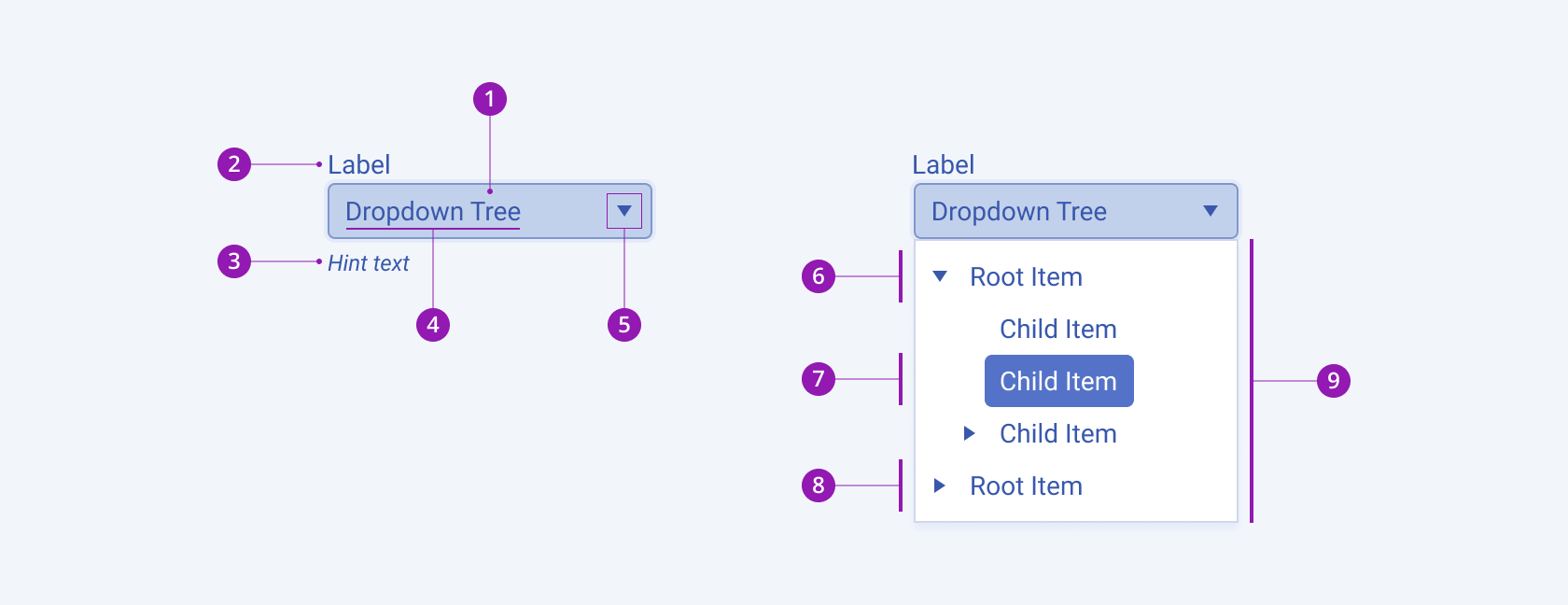DropDownTree Overview
A DropDownTree is a user interface (UI) element, that combines the functionality of a drop-down list and a hierarchical tree structure. It enables users to select a single value from a list of predefined options organized in a hierarchical manner, making it suitable for scenarios where complex data categorization is required. With its intuitive interface and interactive tree view, the DropDownTree provides an efficient and user-friendly way to navigate and select options within nested categories.
Live Demo
Appearance
The DropDownTree provides built-in styling options that grant visually appealing and flexible rendering experience.
Apart from the default vision of the Telerik and Kendo UI DropDownTree, the component supports alternative styling options which enable you to configure the individual aspects of its appearance.
States
Depending on the action you want to imply through its appearance, the Telerik and Kendo UI DropDownTree can acquire the following states which you can set by using the following classes:
- A DropDownTree in its normal state is not being interacted with by the user. The control displays a placeholder or the preselected value.
k-hover—When a user hovers over a DropDownTree, it enters the hover state. This state indicates that the control is interactive, and that the user can click on it to open a dropdown list.k-focus—When a user clicks or tabs into a DropDownTree, it enters the focus state. This state indicates that the control is active and ready to receive user selection and includes a visual indicator such as a highlighted border.k-invalid—If there is an error with the user's selection in the DropDownTree, it enters an error state. This state includes a visual indicator such as a red border and validation icon to indicate that there is an issue with the selection.k-invalid k-focus—The invalid focus state of the DropDownTree is a result of spotlighting a DropDownTree whose value or input type does not pass the validation requirements.k-disabled—The disabled state indicates that a DropDownTree is temporarily unclickable and users cannot interact with it. To indicate that they are unavailable, DropDownTrees in their disabled state are usually faded and slightly out of focus.
Anatomy
The anatomy of the DropDownTree summarizes the elements of the component.
The next image shows the anatomy of a DropDownTree and includes the following elements:

- Container
- Label (optional in Form components)
- Hint text (optional in Form components)
- Placeholder or preselected value
- Icon button
- Expanded Root item
- Selected Child Item
- Collapsed Root Item
- Popup with tree items
Size
The DropDownTree provides the size configuration option that enables you to control how big or small the rendered DropDownTree will be. DropDownTrees also provide options for size customization.
size provides the following available options:
small—Renders a small drop-down tree, which is suitable for compact components, such as Toolbars, where the available space is limited.medium(default)—Renders medium drop-down trees.large—Renders large drop-down trees, which are suitable for adaptive designs.none—Does not set asizeand allows you to add your own, custom value.

- Small
- Medium (default)
- Large
Fill Mode
The DropDownTree provides the fillMode configuration option that enables you to control the way in which color is applied to the rendered DropDownTree. DropDownTrees also provide options for fill-mode customization.
fillMode provides the following available options:
solid(default)—A solid drop-down tree puts stronger emphasis on the action it indicates and draws the attention of users. It is also the traditional and common style that is widely used.outline—An outline drop-down tree provides a minimalistic look, and can be a good choice when you want the component to blend in with the background or other UI elements.flat—A flat drop-down tree provides a very minimalistic and clean look, and can be a good choice when you want the component to be unobtrusive for the background or other UI elements.

- Solid (default)
- Outline
- Flat
Border Radius
The DropDownTree provides the rounded option that enables you to control how much border radius will apply to the rendered DropDownTree. DropDownTrees also provide options for border-radius customization.
rounded provides the following available options:
small—Renders a border radius of 2 px.medium(default)—Renders a border radius of 4 px.large—Renders a border radius of 6 px.full—Renders a border radius of 9999 px.none—Does not set aroundedand allows you to add your own, custom value.

- Small
- Medium (default)
- Large
- Full
Framework-Specific Documentation
For specific information about the component, refer to its official product documentation:




